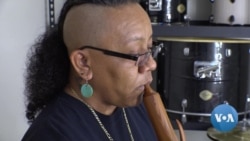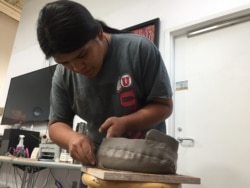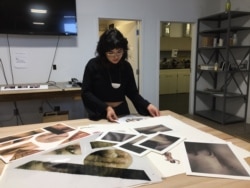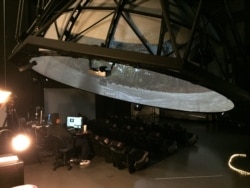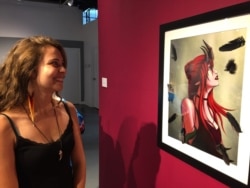The sprawling buildings of the Institute of American Indian Arts (IAIA) in Santa Fe, New Mexico stand out against the stunning desert landscape of the American Southwest.
Birthplace of Contemporary Native Arts
Here, on this quiet, 56-hectare (140-acre) campus, about 500 students are immersed in contemporary Native American arts and culture.
It's the only college in the U.S. like it, which could explain why it attracts both native and non-native people from across the country — and overseas — who wish to explore their artistic abilities while learning more about the diverse range of native cultures in America.
Some come to paint or sculpt; others want to examine the art of poetry and storytelling, while those with cinematic interests aspire to find a niche in New Mexico's thriving film business.
A Fine Arts School in a Fine Arts Town
IAIA President Robert Martin, an enrolled member of the Cherokee Nation, says members of about 100 tribes on average attend the school.
"So that's a lot of diversity. And, of course, we also have non-native students as well — we're open to everybody."
But the school's mission, "will always reflect that indigenous or Native perspective," he emphasizes. "I think that's [an] important aspect of what we have here; a sense of community, almost a sense of family."
Aspiring Artists
Daniel Yazzie Natonabah feels that connection.
"Growing up on the reservation I was entirely isolated," he observes. "I was surrounded by other native tribes and my whole perspective of the world was just Navajo. But when I came here I've learned other perspectives of Yaqui, Tohono Oʼodham, Pueblos."
Dolores Scarlett Cortez is exploring her roots through printmaking and photography.
"I came to the Institute of American Indian Arts, primarily because it was a small institution... and it would also allow me to come back to my roots a little bit because … growing up I felt like I was really missing that kind of side of me because my parents never talked about it."
"So what I'm hoping to do is go back to my community to document the people back home that I really care for," she adds.
That feeling of giving back to the community is not unusual among the students, says Martin.
"If you ask the average college student why they're going to college, they'll say, 'I want a job.'" He says. "You ask our students and they'll say, I want to be of service to my family and my community.' And so that makes our students different."
Symbolic Stones
During an outdoor class presentation, student Daniel Forest describes his creation — a pile of large, cascading stones that he's arranged in the corner of the small courtyard. Titled Shelter, they look like loaves of bread.
"It pulls for me from the current border crisis, people trying to make their way to a safe haven from Central and South America and Mexico. And the very sad nature of all that," he tells the group gathered around.
Shelter, something which we are all in a way looking for and trying to maintain, he explains, and possibly a grave marker, for someone who's passed on."
"They also feel like loaves of bread, which is sustenance that we all need for survival," he explains. "But something many people have to go without," he adds. "So this is not a happy piece for me… it's very, very emotional."
"I didn't know when I came to the school exactly how it would change me," he says afterwards, about his experience at the school. "I've been here for two months, and I already see that the real goal isn't the art degree — it's the shift in consciousness that I'm developing while I'm here."
"I'm learning how to walk differently; really pay attention," he says. "Because western culture tends to be a little conquistador' — a little aggressive — and that doesn't work here. So I'm learning to just recalibrate everything."
Looking in from the outside
Creative Writing major Annabella Farmer, says being a non-native has given her a unique perspective into Native American culture.
"I grew up in Santa Fe, so I wanted to understand more about the land where I grew up," she says. "To be in the minority here I think is a good growth experience for me… I think that the culture here is just much more welcoming of different perspectives…a more matriarchal society perhaps, which I've really enjoyed."
Congressionally chartered
While IAIA was founded more than 55 years ago, it moved to its permanent campus in August 2000. It's been here where students have been experiencing the benefits of a small school environment while receiving a quality fine arts education in a supportive and nurturing environment.
The school is one of 37 tribal colleges in the U.S., "but instead of being chartered by a tribe, we're chartered by the United States Congress," explains Martin. "Just as [DC-based] Howard University and Gallaudet University are."
A large percentage of students are on a scholarship.
"Well, we are the birthplace of contemporary native arts and so that's always been a priority; how to advance scholarship and contemporary native arts and I think going forward, that's going to be our goal."
Paying It Forward
Many of the school's graduates return to teach there years later.
Anthony Deiter, who graduated 25 years ago, teaches a new concept in filmmaking; a digital dome where viewers watch moving images on a spherical screen rather than a flat one.
Digital Dome
"This dome in particular, is an articulating dome, and that means it's capable of movement. And at the time of its inception here, it was the only dome of its kind in the world," he explains.
The new technology is very fitting given his native background.
"We're indigenous cultures, and we are not linear, we're spherical, we're round. And all of a sudden here's a media that's totally immersive for us to tell our stories actually in the round," he said.
Which is technologically and culturally a perfect balance, he says.
"I think they estimate since the inception of Hollywood, 4000 movies have involved Native Americans," he says. "My challenge to the industry would be this, okay; we've heard what you have to say about us, now you're going to hear what we have to say about us!"
Loud and Clear… Everywhere
Students and graduates of the Institute of American Indian Arts are expressing themselves loud and clear.
Many of the IAIA students' artwork were recently on display at a campus gallery, which international student Erika Knecht helped put together.
Her goal upon graduation she says, is to promote contemporary native artists in Europe, especially in her native Germany where she's already established contacts.
In addition to abundant displays of their artwork on campus, students' creations are also on exhibit at IAIA's Museum of Contemporary Native Arts in downtown Santa Fe where Native American artists such as T.C. Cannon have gone on to become internationally famous.
"Everywhere that you go, not only here in Santa Fe, but wherever there's native art being exhibited, more than likely you're also going to see that it has some connection, either a current student and alum, or faculty member, with the Institute of American Indian Arts," Robert Martin says.
* An earlier version of this article included an incorrect reference to a painter identified as Renee Chavez. That reference has been deleted.




